scavenger; probably a harmless omnivore in bee nests
Tydeus Koch, 1836
Note: There is no agreement on the year of the original description of Tydeus Koch. Most workers agree that the first description of Tydeus appeared in "Koch, C.L. Deutschlands Crustaceen, Myriapoden und Arachniden. Ein Beitrag zur deutschen Fauna, Heft 4 (=Heft 137)" (not seen by us). The most recent treatment cites the year as 1836 (André, 2005), with a discussion on publication date of Heft 4 - either 1836 or 1837 and the warrant that the year cannot be found on the author's personal reprint. Oudemans gives the same year for Heft 4 (Oudemans, 1937bOudemans, 1937b:
Oudemans, A. C. 1937b. Kritisch historich overzicht der acarologie door Dr. A. C. Oudemans. Derde Gedeelte 1805-1850, Band C. Leiden: E. J. Brill. i-xxiii, 799-1348 pp.). However, the Nomenclator Zoologicus online database indicates that Heft 4 had been published in 1837. Kaźmierski gives 1835 for Tydeus Koch, without explicitly citing the original Koch's work or any further discussion on the matter (Kaźmierski, 1989Kaźmierski, 1989:
Kaźmierski, A. 1989. Revision of the genera Tydeus Koch sensu André, Homeotydeus André and Orthotydeus André with description of a new genus and four new species of Tydeinae (Acari: Actinedida: Tydeidae). Mitteilungen aus dem Hamburgischen Zoologischen Museum und Institut . 86 : 289-314.). Here we follow André, 2005 and André and Kaźmierski, 2006, citing the year of the original description of Tydeus as 1836.
Superorder Acariformes » Order Trombidiformes » Suborder Prostigmata » Infraorder Eupodina » Family Tydeidae » Genus Tydeus
Tydeus spathulatus Oudemans, 1928. Designated by Opinion 2190 ICZN (2008), see Case 3354 (André and Kaźmierski, 2006).
The complicated synonymy of this genus was discussed in André, 2005.
Female: Palptarsus unmodified, not thumblike (Fig. 1). No markedly elongated setae on palptarsus (Fig. 2). Palptibia without claw-like setae. CheliceraeChelicera:
Anterior, paired appendage of the body. Primary organ for food acquisition, adapted for chewing, piercing, tearing, sucking, or filtering.
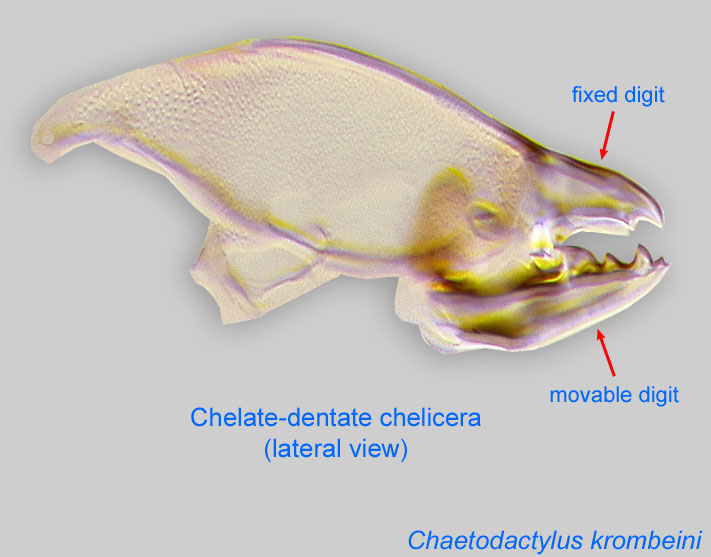 contiguous (Fig. 1). Movable digit of cheliceraechelicera:
contiguous (Fig. 1). Movable digit of cheliceraechelicera:
Anterior, paired appendage of the body. Primary organ for food acquisition, adapted for chewing, piercing, tearing, sucking, or filtering.
 stylet-like (Fig. 1). Naso absent (Fig. 1). Prodorsalprodorsal:
stylet-like (Fig. 1). Naso absent (Fig. 1). Prodorsalprodorsal:
Pertaining to the prodorsum.
bothridial setaebothridial seta:
A modified seta inserted in a cup-like base (bothridium); forms include filiform and capitate. Also known as bothridial sensillum and trichobothrium.
present (Fig. 1). Oviporeovipore:
Opening of female which serves as an outlet for oviposition. In Astigmata and non-astigmatan Oribatida, situated between genital valves. In Astigmata, not to be confused with the copulatory opening (which serves for sperm intake).
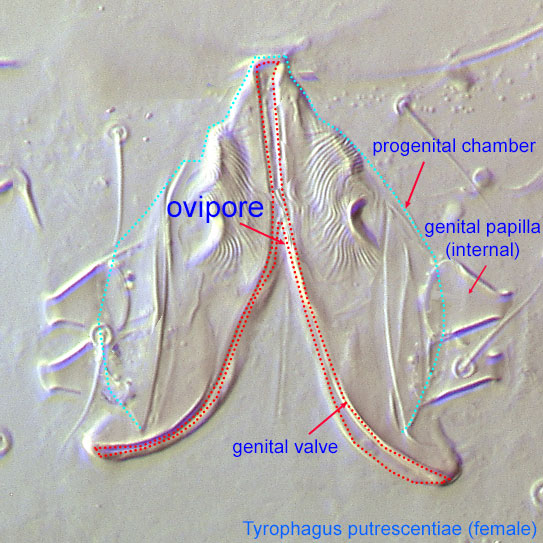 longitudinal (Fig. 2). No net-like ornamentation on legs and prodorsumprodorsum:
longitudinal (Fig. 2). No net-like ornamentation on legs and prodorsumprodorsum:
Dorsal surface of propodosoma.
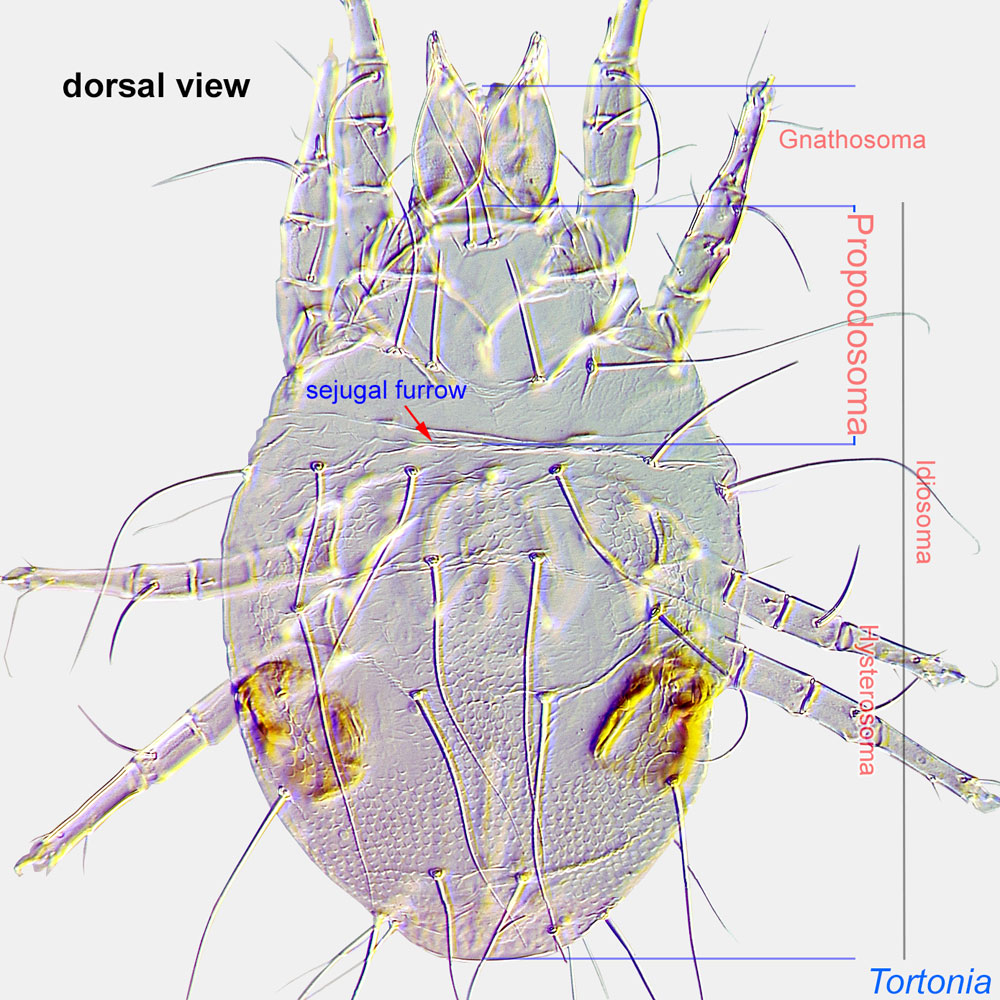 (Fig. 1). Tarsustarsus:
(Fig. 1). Tarsustarsus:
Terminal segment (also known as podomere or palpomere) of legs or palps. In Parasitoformes it can be subdivided into telotarsus and basitarsus.
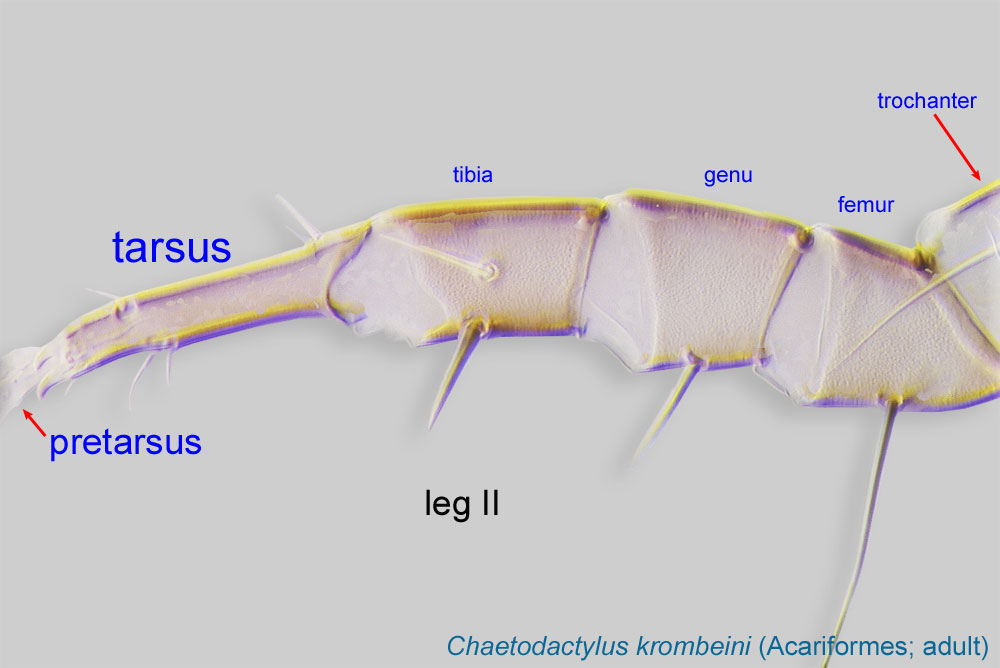 I with claws (Fig. 2). No trichobothriatrichobothrium:
I with claws (Fig. 2). No trichobothriatrichobothrium:
Modified seta that can be distinguished from true seta by its distinct large socket (complex cup-like cavity), and often, shape (which may be filiform, ciliate, pectinate, or thickened or clubbed). Present in many Acariformes (except Astigmata) and Opilioacarida (Parasitiformes). When paired and situated on the propodosoma, termed "prodorsal."
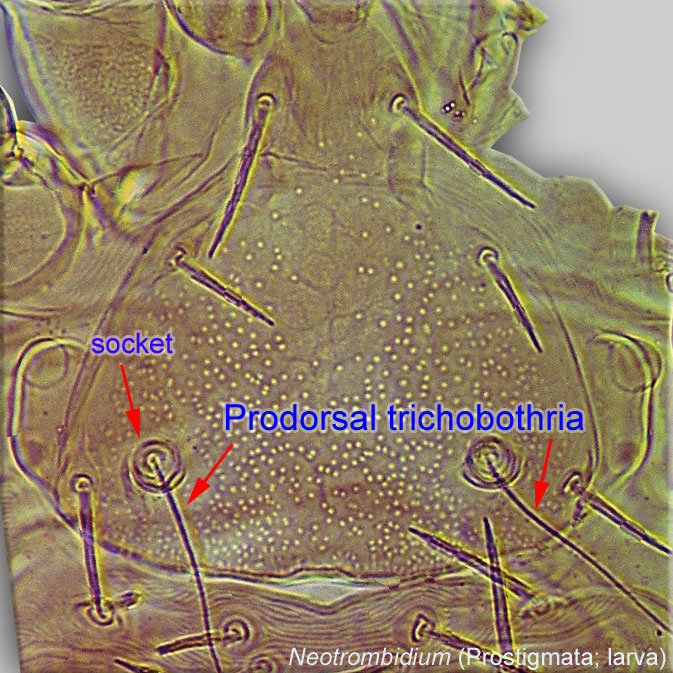 on tibiatibia:
on tibiatibia:
Leg or palp segment (also known as podomere or palpomere) between tarsus and genu.
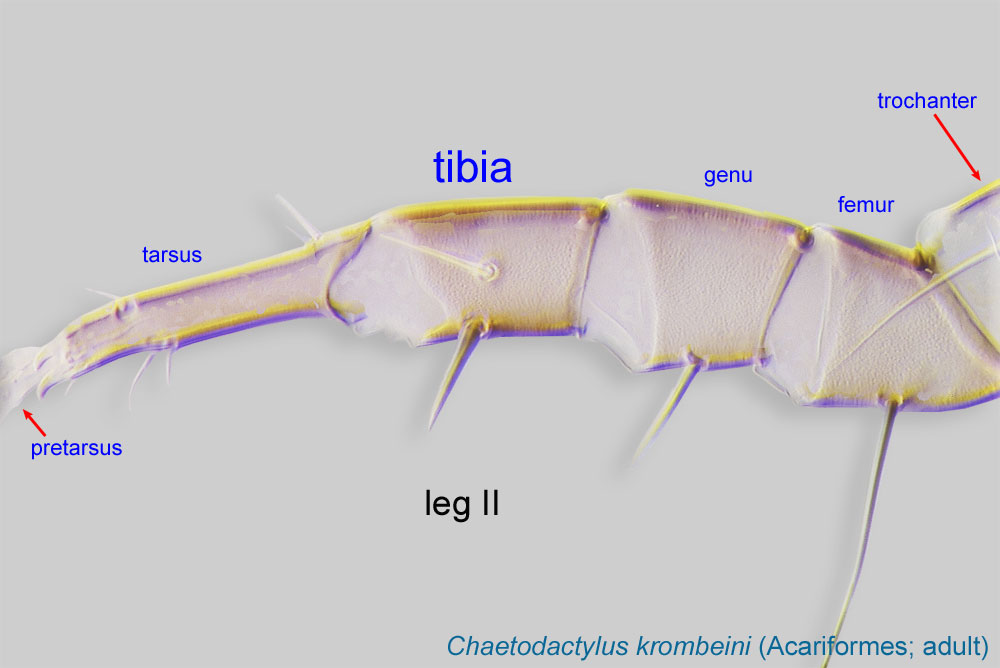 IV (Fig. 2).
IV (Fig. 2).
Only two species of Tydeus have been recorded in association with bees: Tydeus interruptus Thor, 1932 and Tydeus xylocopae Oudemans, 1926. The former species was redescribed in Hughes, 1976Hughes, 1976:
Hughes, A. M. 1976. The mites of stored food and houses. London: Her Majesty's Stationery Office. 400 pp.. However, these two species were recently treated as species inquirendae, since the original and subsequent descriptions are not sufficient for reliable identifications (Kaźmierski, 1998Kaźmierski, 1998:
Kaźmierski, A. 1998. A review of the genus Proctotydaeus Berlese (Actinedida: Tydeidae: Pronematinae). Acarologia.39: 33-47.). No key to species is available.
Cosmopolitan; bee-associated species have been found in Palaearctic, Oriental, and Australian regions.
A few species have been recorded from nests of bumble bees (Bombus), the European honey bee (Apis mellifera), and a carpenter bee (Xylocopa sp.).
facultativefacultative:
can complete entire life cycle without bees or their close relative, wasps
The majority of species of Tydeus are moss inhabitants (Momen and Lundqvist, 2005Momen and Lundqvist, 2005:
Momen, F. amp; L. Lundqvist. 2005. The genera Metalorryia and Tydeus (Acari: Prostigmata: Tydeidae), new and unrecorded species from south Sweden. International Journal of Acarology . 31 : 225-236.). Some species occur on tree foliage, stored products, vertebrate nests, and beehives. They are omnivorous scavengers and can also prey on the smallest arthropods and their eggs (Kaźmierski, 2009Kaźmierski, 2009:
Kaźmierski, A. 2009. Three new Tydeinae species (Acari: Actinedida: Tydeidae) from Poland. Annales Zoologici . 59 : 107-117.). Unidentified species of Tydeus have repeatedly been collected in beehives throughout the world (Haragsim et al., 1987Haragsim et al., 1987:
Haragsim, O., K. Samšiňák amp; E. Vobrázková. 1978. The mites inhabiting the bee hives in ČSR. Zeitschrift für Angewandte Entomologie. 87: 52-67., Homann, 1933Homann, 1933:
Homann, H. 1933. Die Milben in gesunden Bienenstöcken. Zeitschrift für Parasitenkunde 6: 350-415., Kamali et al., 2001Kamali et al., 2001:
Kamali, K., H. Ostovan amp; A. Atamehr. 2001. A Catalog of Mites and Ticks (Acari) of Iran. Islamic Azad University Scientific Publication Center. 196 pp.; Malabanan and Corpuz-Raros, 1998Malabanan and Corpuz-Raros, 1998:
Malabanan, J. M. amp; L. A. Corpuz-Raros. 1998. Mites associated with Apis mellifera Linnaeus and Apis cerana Fabricius in the southern Tagalog region, Philippines. Philippine Entomologist . 12 : 123-135.) or in bumble bee nests (Chmielewski, 1971Chmielewski, 1971:
Chmielewski, W. 1971. The mites (Acarina) found on bumble-bees ( Bombus Latr.) and their nests. Ekologia Polska.19: 57-71.). Tydeus interruptus has been found in nests of introduced bumble bees in New Zealand (Macfarlane, 2005Macfarlane, 2005:
Macfarlane, R. P. 2005. Mites associated with bumble bees ( Bombus : Apidae) in New Zealand. Records of the Canterbury Museum . 19 : 29-34.), and Tydeus xylocopae in the nest of a large carpenter bee (Xylocopa sp.) in Indonesia (Oudemans, 1926bOudemans, 1926b:
Oudemans, A. C. 1926b. Acarologische Aanteekehingen LXXX. Entomologische Berichten (Amsterdam).7: 67-80.).